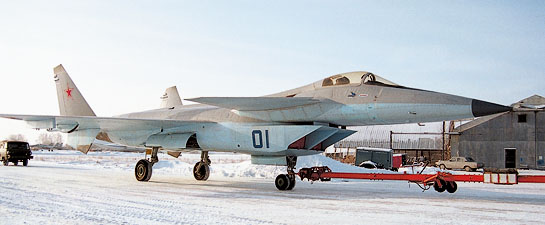MiG's Fifth Generation Fighter Builds up New Momentum
 The Russian Air Force made an unexpected shift in the priorities for its future fighter, stating that the service will back the simultaneous development of two programs for a fifth-generation aircraft. The PAK FA medium-weight fighter program, which has been underway since 2002, is joined by MiG's lighter-weight aircraft project. In addition to the goal of winning domestic orders, MiG's light multi-role fighter build on the company's earlier experience with its MiG 1.44 program, also may attract India as a co-developer and future customer.
The Russian Air Force made an unexpected shift in the priorities for its future fighter, stating that the service will back the simultaneous development of two programs for a fifth-generation aircraft. The PAK FA medium-weight fighter program, which has been underway since 2002, is joined by MiG's lighter-weight aircraft project. In addition to the goal of winning domestic orders, MiG's light multi-role fighter build on the company's earlier experience with its MiG 1.44 program, also may attract India as a co-developer and future customer.
In April 2002, the Russian military chose Sukhoi's T-50 proposal in the fifth-generation fighter contest — which was codenamed the Perspektivniy Aviatsionniy Kompleks Frontovoi Aviatsii (PAK FA), or future tactical aviation air system. Since 2002, Sukhoi has been regularly meeting the subsequent milestones in the new fighter's development, which led to the Russian Air Force's approval of the T-50's preliminary design. To date, Sukhoi has developed a computer mock-up of the aircraft and an operating mockup of the cockpit. The PAK FA prototype's maiden flight is expected in 2009.
Sukhoi's victory in the Russian Air Force competition resulted not only from the T-50's design characteristics. The choice was made with the consideration of the company's sizeable profits from the sales of the Su-27 family aircraft to China and India in the 1990s and early 2000s. At that time, Sukhoi fighters represented half of Russia's aircraft production, and nearly half of Russian military technology exports. During the 1990s, Sukhoi maintained the largest workload of all Russian design bureaus. Unlike other Russian aircraft designers, the company counted more on its own resources than on government subsidies.
The Sukhoi T-50's rival in 2002 was the MiG design, the exact designation of which is classified. Later, when MiG Corp. decided to continue this program, it received the codename Liogkiy Mnogofunktsionalniy Frontovoi Samolyot (LMFS) or Light Multi-role Tactical Aircraft. MiG Corp. did not accept defeat in the contest against Sukhoi, and criticized the decision-making procedure. According to MiG, several aspects were omitted during the evaluation, like the purchase cost for the Air Force, the aircraft's lifetime maintenance costs and the export possibilities of various versions during the next few decades. MiG insisted that instead of initial projects, the choice of a winner should have been made at the phase of prototype tests.
Это закрытый материал портала ATO.RU.
Полный текст материала доступен только по платной подписке.
Вопросы, связанные с платным доступом, направляйте на адрес paywall@ato.ru
Для пенсионеров у нас 50% скидка на все виды доступа. Зарегистрируйтесь на сайте под своим реальным ФИО (например, Иван Иванович Ивванов), указав, что Вы пенсионер, и отправьте с емэйла, который указали при регистрации скан/фотографию подтверждающего документа по адресу jkabardina@ato.ru.
Услуга "Автоплатеж". За двое суток до окончания вашей подписки, с вашей банковской карты автоматически спишется оплата подписки на следующий период, но мы предупредим вас об этом заранее отдельным письмом. Отказаться от этой услуги можно в любое время в личном кабинете на вкладке Подписка. Подробные условия автоматической пролонгации подписки.
Я подписчик / Я активировал промокод.
Если у вас есть неактивированный промокод, авторизуйтесь/зарегистрируйтесь на сайте и введите его в своем Личном кабинете на вкладке Подписка
Ссылки по теме
- Для того, чтобы оставить комментарий, не привязанный к социальной сети, войдите или зарегистрируйтесь на нашем сайте.
CIS & Russian Aviation News And Insights
- Russian airlines’ traffic drops two per cent so far in 2025
- Ural Airlines’ operational performance affected by A320neo groundings
- Volga-Dnepr Group founder warns the company may be nationalized
- Aeroflot revenue grew 10 per cent during first half of the year
- Russian airlines’ January through July traffic and RPKs decline
- Aeroflot Bonus members can now access the full range of services
- A manufacturing defect has been discovered in Superjet 100 aircraft









